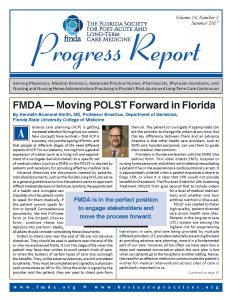FMDA – Moving POLST Forward in Florida

FMDA – Moving POLST Forward in Florida
by Kenneth Brummel-Smith, MD, Professor Emeritus, Department of Geriatrics, Florida State University College of Medicine
Advance care planning (ACP) is getting increased attention throughout our nation. New concepts have evolved – that ACP is a process, not just the signing of forms, and that people at different stages of life need different aspects of ACP. For our patients, moving from a general expression of wishes (such as a living will and appointment of a surrogate decision-maker) to a specific set of medical orders (such as a DNRO or the POLST) is desired by patients and necessary for providing effective medical care.
Advance directives are documents created by patients. Individual documents, such as the Florida Living Will, can serve as a general guideline as to how the patient wants to approach difficult medical decisions in the future. Similarly, the appointment of a health care surrogate can stipulate who the patient wants to speak for them medically if the patient cannot speak for him or herself. Comprehensive documents, like the 5-Wishes form or the Empath Choices form, combine these two decisions into one form. Ideally, all adults should consider completing these documents.
Orders to direct care near the end of life are not advance directives. They should be used in patients near the end of life or who have advanced frailty. It is in this stage of life when the patient may have clear wishes to avoid certain kinds of care, or when the burdens of certain types of care may outweigh the benefits. They, unlike advance directives, are not completed by patients. They must be completed and signed by a physician (and some states an NP or PA). Once the order is signed by the provider and the patient, they are used to direct care from then on. The patient (or surrogate if appropriate) can ask the provider to change the orders at any time. But the key difference between them and an advance directive is that other health care providers, such as EMTs and hospital personnel, can use them to guide their medical interventions.
Providers in Florida are familiar with the DNRO (the yellow) form. This order directs EMTs, hospital or nursing home personnel, and others not attempt resuscitating a patient if he or she experiences a cardiopulmonary arrest. It is appropriately ordered when a patient expresses a desire to forgo CPR, or when it is clear that CPR would not provide benefits to the patient. The Physician Orders for Life-Sustaining Treatment (POLST) form goes beyond that to include orders for a level of medical interventions and whether and how artificial nutrition will be used.
POLST was created to foster high-quality, patient-directed care across health care sites. Patients in long-term-care (LTC) system are among the highest risk for experiencing transitions in care, and care being provided by multiple different providers. LTC providers nationally are among the best at providing advance care planning, since it is a fundamental part of our care. However, all too often we have seen how a deep and repeated conversation about the care plan is lost when our patients go to the hospital or another setting. Hence, the need for an effective method to communicate the patient’s wishes for medical intervention across sites of care is particularly important to us.
